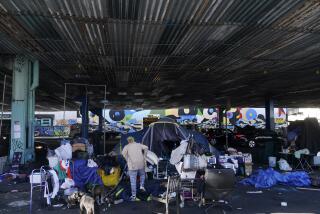S. African Squatters’ Misery Worsening : Homeless: Urban Foundation estimates that 7 million people live in makeshift quarters.
- Share via
SOWETO, South Africa — According to her Zulu tradition, Magdeline Maphalala is not supposed to undress in front of any man except her husband.
But Magdeline was among a group of black South African women who stripped to their underwear and stood in front of bulldozers one winter morning in a vain attempt to stop municipal workers from demolishing their shanties.
“We thought the municipal policemen would respect the black tradition and culture, value women’s naked bodies, and would stop knocking down our shanties,” Maphalala said.
She is one of the 2 million squatters estimated by development experts to be scattered throughout the Pretoria-Johannesburg industrial heartland.
As she spoke she stood guard over belongings salvaged from the wreck of the shack she shared with her husband and four children in the Dobsonville area of Soweto township.
The shack, like 68 others that day, was flattened.
The Urban Foundation, a privately funded development agency estimates that 7 million people live in garages, squatter huts and back-yard shacks built of wood, tin and plastic.
Human rights research groups say Pretoria would need to build about 800 houses a day to solve the black housing backlog. They say there is a shortage of at least 2 million dwellings in black townships while there is an oversupply of about 450,000 houses in white areas.
About 70% of urban blacks have no direct access to running water or electricity. Up to 40% are unemployed.
Since the beginning of June, municipal authorities across South Africa have been tearing down squatter camps inhabited by rural blacks who have flocked to the cities in search of jobs.
Human rights organizations say the squatters are victims of Pretoria’s failed attempts at social engineering, which uprooted 3.5 million blacks from land they had occupied for generations and dumped them in homelands ruled by blacks chosen by Pretoria.
Like millions of other homeless people, Maphalala came to Johannesburg from one of 10 “tribal homelands” created by Pretoria for blacks as part of its racial segregation policy.
She arrived 10 years ago to join her husband and seek work but, because he lived in a single men’s hostel at the time, they built a shack in the back yard of sympathetic Soweto residents.
For the next five years, the Maphalalas wandered from one back-yard shack to another trying to escape the wrath of unscrupulous landlords.
They signed up on a government waiting list but after five more years they joined hundreds of other homeless Sowetans in erecting shacks in an open field in Dobsonville.
“First we were tired of the money-mongering landlords, tired of waiting for the municipality to allocate us a government house, secondly we wanted to find a place of our own,” she said. “When we moved into the squatter camp, it was like a dream come true.”
In mid-July, municipal workers acting on orders from the local council used two bulldozers to knock down 69 shanties, including the Maphalalas’. Those who resisted were arrested.
Almost naked in an attempt to shame the workers into stopping the demolition, Maphalala and others asked for a reprieve until their families could find another place. But police supporting the workers refused to suspend the operation.
The families tried to rebuild, but the next day at 2 a.m. police returned and knocked the shacks down again, leaving the dwellers shivering in an icy wind.
The temperature at night around Johannesburg, 5,800 feet above sea level, can fall in winter to 14 degrees Fahrenheit.
Maphalala and 20 others have been allowed to stay at a local church but her two small children have caught measles and bronchitis.
Anti-apartheid organizations say authorities deliberately move against squatters in winter because the cold forces those without shelter to return to their homes in the countryside.
Authorities have demolished squatter camps in other areas around Johannesburg.
More to Read
Sign up for Essential California
The most important California stories and recommendations in your inbox every morning.
You may occasionally receive promotional content from the Los Angeles Times.













